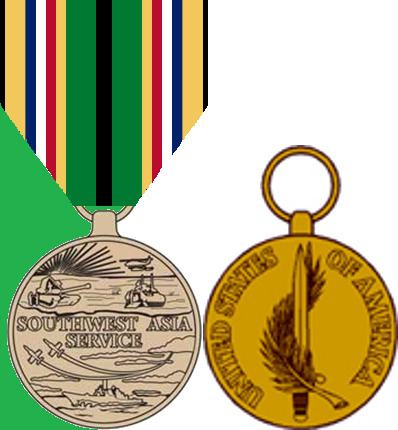Type Campaign Medal | Status Not currently awarded | |
 | ||
Eligibility August 2, 1990 – November 30, 1995 Established EO 12754, March 12, 1991, as amended First awarded January 17, 1991 (retroactive) Last awarded November 30, 1995; 21 years ago (1995-11-30) | ||
The Southwest Asia Service Medal (SASM) is a military award of the United States Armed Forces which was created by order of President George H.W. Bush on March 12, 1991. The award is intended to recognize those military service members who performed duty during the years of the Persian Gulf War. The medal was designed by Nadine Russell of the Army's Institute of Heraldry. The colors of the ribbon are tan, representing sand, with the black, white, red, blue, and green colors symbolizing the colors of coalition countries' national flags.
Contents
History
Individuals awarded the Southwest Asia Service Medal must have participated in or supported military operations in Southwest Asia between August 2, 1990 and November 30, 1995. That period of inclusion includes participation in Operations Desert Shield or Desert Storm:
Individuals serving in Israel, Egypt, Turkey, Syria and Jordan (including the airspace and territorial waters) directly supporting combat operations between January 17, 1991 and April 11, 1991 are also eligible for this award.
To receive the award, a service member must be: attached to or regularly serving for one or more days with an organization participating in ground/shore military operations; attached to or regularly serving for one or more days aboard a naval vessel directly supporting military operations; actually participating as a crew member in one or more aerial flights directly supporting military operations in the areas designated; or serving on temporary duty for 30 consecutive days or 60 nonconsecutive days, except, if a waiver is authorized for personnel participating in actual combat.
For those service members who performed "home service" during the Persian Gulf War, such as support personnel in the United States, the Southwest Asia Service Medal is not authorized. The award is also not authorized for those who performed support of the Persian Gulf War from European or Pacific bases.
Designated campaigns are as follows:
While several operations occurred in the geographical areas described above between April 12, 1991, and November 30, 1995, including Operation Provide Comfort (June 1, 1992 – November 30, 1995), Operation Southern Watch (August 27, 1992 – April 29, 2003) and Operation Vigilant Warrior (October 14, 1994 – December 21, 1994), these operations were covered under the third campaign, Southwest Asia Cease-Fire. Service in Operations that extended beyond the final campaign date of November 30, 1995 were recognized by awards of either the Armed Forces Expeditionary Medal or the Armed Forces Service Medal. Thus, the maximum number of bronze service stars that are authorized to be worn for the Southwest Asia Service Medal's ribbon or streamer is three.
2016 redesign
In April 2016, the appearance of the suspension and service ribbon of the SASM was slightly modified by the United States Department of Defense through its Defense Logistics Agency (DLA). The DLA made the two vertical green bars and one vertical black bar in the middle wider than in the original 1991 version.
